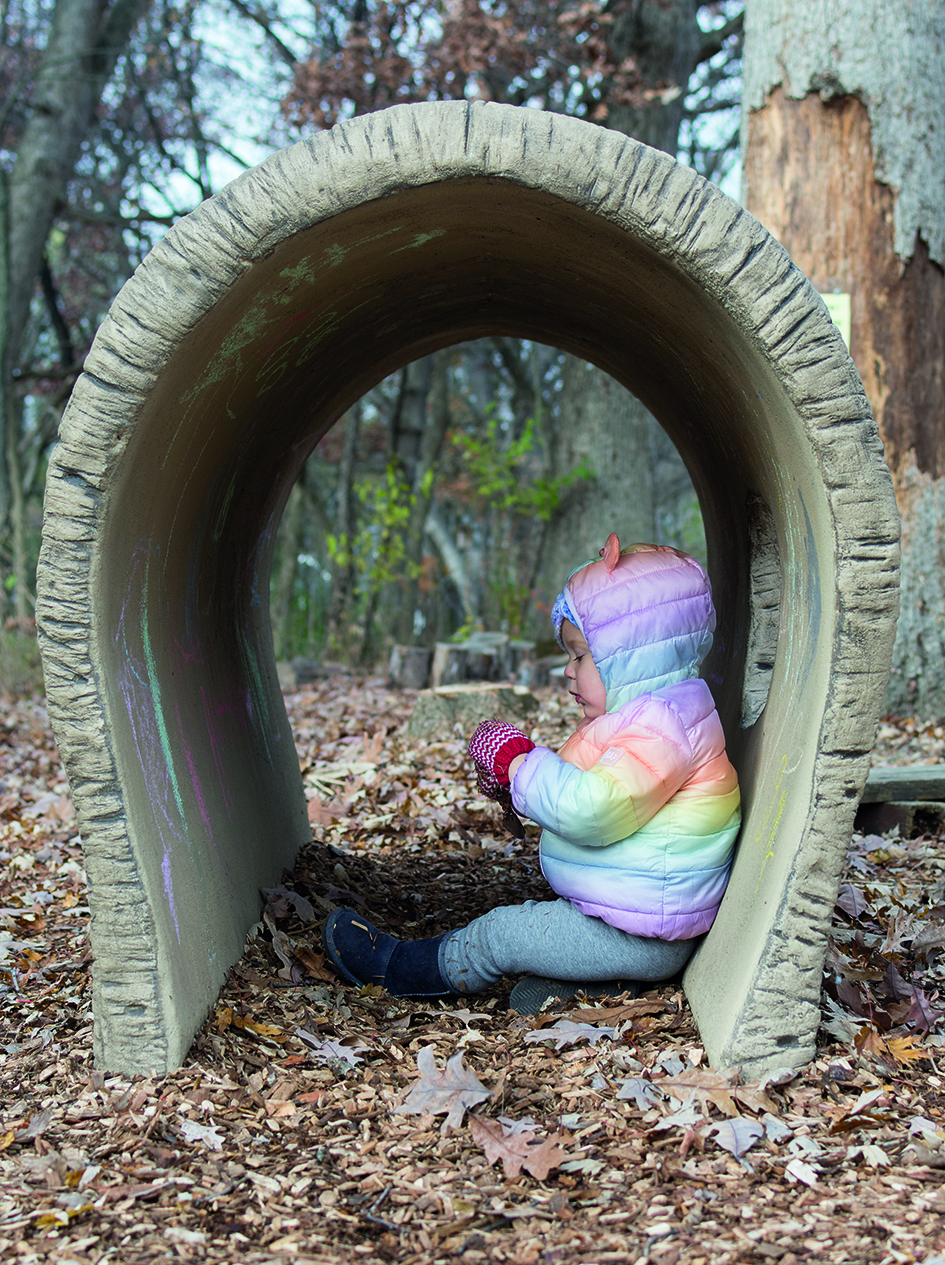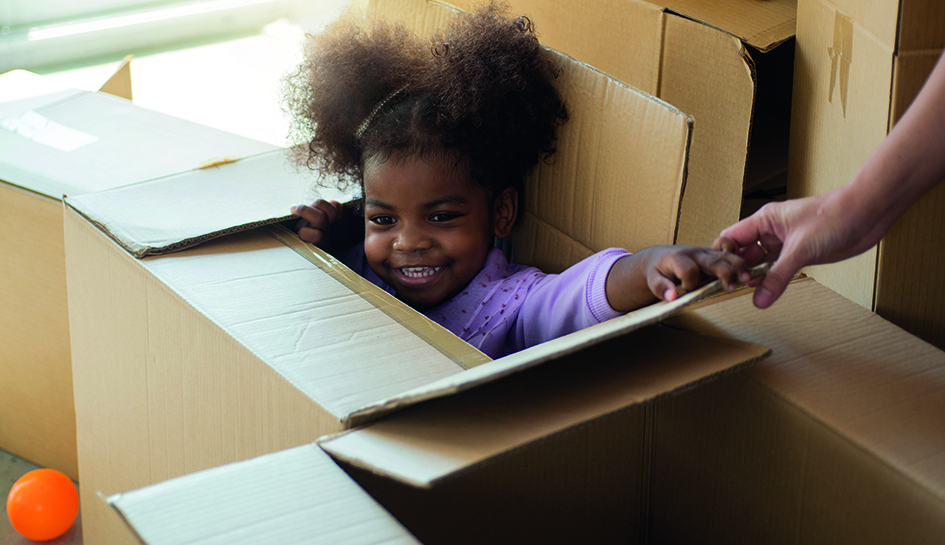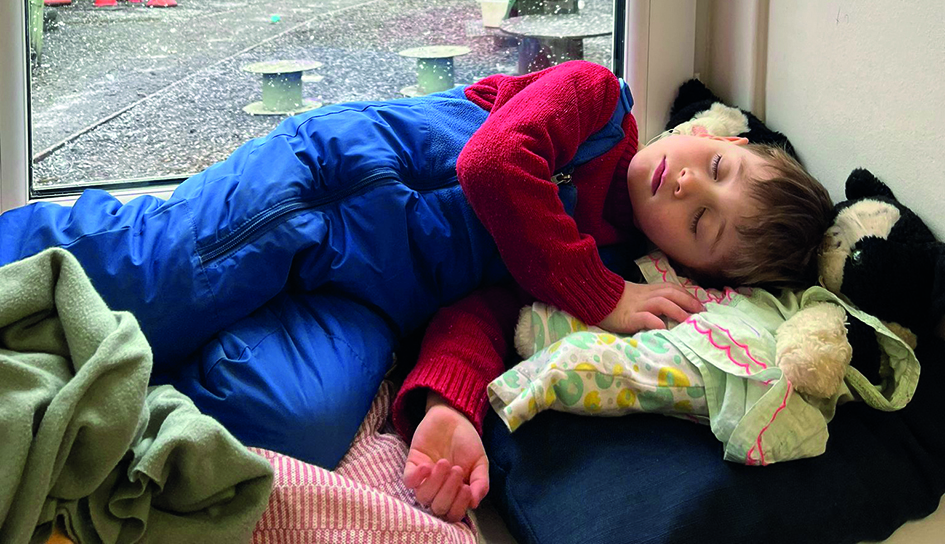
Look around your setting and you will notice that certain children consciously seek out small spaces – hiding in a den, curling up with a friend in the corner of a sofa, tucking themselves behind trees or squashing into a cupboard. But why are these areas so appealing?
‘We all recall the secret places we would hide in as a child, and that comforting feeling of being cocooned,’ says Sarah Watkins, associate lecturer at the University of Worcester and Forest School leader. ‘The world can be a confusing place for young children, with many things to process, and secret hiding places offer comfort as well as a break from adult surveillance.’ There is also a sense of excitement gained from being in an area where an adult can’t easily gain access, or from being somewhere dark.
Specialist early years educational psychologist and chartered member of the British Psychological Society Dr Abigail Wright refers to evolution and how retreating to small spaces is a means of self preservation. ‘A feeling of physical security is one of the main elements of small spaces– acting as a supportive barrier from something that could be challenging but also for emotional security as well,’ she explains. ‘A small space can shield us from any challenges in the environment.’
Wright says small spaces can provide a place of retreat from the busy nursery and enable children to self-regulate. ‘There are the sensory aspects of a small space which leads to security too – a place where you can self-soothe, or soothe with another person and find your calm again,’ she adds.
We often associate feelings of attachment as being linked to people, but Wright says children can gain this from places too. ‘The need for having a secure base can also be linked to attachment,’ she says. ‘We can attach ourselves to familiar, small spaces to provide security when things feel a bit risky, perhaps because things are challenging for us, the need for a sensory environment or because the place is unfamiliar.’
Importantly, Wright adds that practitioners should be mindful of the child. ‘Small spaces for some children may be quite uncomfortable and triggering,’ she warns. ‘It is about thinking what is right for that child at that specific time that will meet their sensory and developmental needs.’
FINDING THE BOUNDARY
 Children may have the urge to try and fit into a small gap as a means of figuring out their growing body, questioning whether they can curl their limbs into the barrel and hide, or looking for ways to gain proprioceptive input from squeezing into a tight space.
Children may have the urge to try and fit into a small gap as a means of figuring out their growing body, questioning whether they can curl their limbs into the barrel and hide, or looking for ways to gain proprioceptive input from squeezing into a tight space.
Penny Greenland, developmental movement specialist and director of Jabadao, explains, ‘Some children want a small space in order to explore their sensory perception, such as whole body touch. Being inside a cardboard box or a Lycra tunnel is what their bodies are seeking. For others, they are using the small spaces to develop their internal body map, building an accurate sense of where their different body parts are.’
Wright adds that the act of getting into small spaces can also appeal to children with enclosure schemas. ‘When children are developing their play skills, one of the key schemas – those natural stages to do things in a certain way during play which are really impactful for cognitive development – is enclosing. So children want to enclose items in containers but also experience it themselves by going into a tent and putting themselves into other small spaces.’
Greenland says that simply getting under a piece of fabric can allow a child to block out what is going on around them and enable them to focus. But children do not have to be physically enclosed to enjoy a small space. She says some children like to make ‘islands’ for themselves on the floor out of mats or blankets where no-one else is allowed to join them and they can engage in focused play.
BREAKING IT DOWN
 Children can yearn for a private space where they do not have to share or interact and can observe others, especially if they are spending long hours in daycare. A large, open area can be quite daunting, whereas a small space provides a more structured environment where children can feel a sense of control over the physical space. ‘In large spaces that are not zoned, children who are quieter or have difficulties with communication can struggle,’ says Watkins. ‘When children are asked what they would change about their outdoor space, they often mention spaces for escape or withdrawal – these are crucial for children to process all they are learning about the world around them.’ (See box, right).
Children can yearn for a private space where they do not have to share or interact and can observe others, especially if they are spending long hours in daycare. A large, open area can be quite daunting, whereas a small space provides a more structured environment where children can feel a sense of control over the physical space. ‘In large spaces that are not zoned, children who are quieter or have difficulties with communication can struggle,’ says Watkins. ‘When children are asked what they would change about their outdoor space, they often mention spaces for escape or withdrawal – these are crucial for children to process all they are learning about the world around them.’ (See box, right).
Small spaces tend to be quiet and can be helpful for children in a high state of arousal. Watkins recommends hammocks for helping children to feel calm and relaxed and as an ideal place for ‘mindful contemplation’.
These places can nurture and encourage small group conversations, whether between a child and practitioner or a few children together. They can be the ideal area for encouraging children’s speech and language skills and particularly beneficial for children with English as an additional language.
‘A few years ago, a child arrived from Syria,’ Watkins recalls. ‘She did not speak and rarely interacted. Two weeks later, I heard her voice for the first time. She was with another child in a secret outdoor space well known to the children. The two were lying in the little hollow of earth behind a bush. One was combing the other’s hair. The new child asked, “Are you my friend?”, and the other replied, “Yes”.’ They became close friends.
CASE STUDY: SEND to Learn in Blyth, Northumberland
‘When we have big boxes in the nursery we find that many of the children want to be in them with the lid closed,’ observes manager Dr Kath Dickinson. ‘There is often a feeling of security from a small space and it is dark, which children can find exciting – it gives an almost scary tingly feeling for the children, but with an element of control because they can choose when to go in and out of the dark.
‘Some children like being in a small space because they can be alone, or there may be two or three children squeezed in a box and they are enjoying the social collaboration and feeling of closeness with others. Children will close the door or put the lid down on a box and then jump out and say “boo!”. They use the enclosed spaces to create games, interact and start friendships.’
Many of the children attending the inclusive nursery are drawn to small spaces both indoors and outdoors – whether that’s tents, tepees and play houses or creating dens with pallets. It is not unusual to see staff and children sat in boxes together or cosied-up in an armchair under a blanket reading books. There is a hammock swing that gives the sense of enclosure, and children can close it right up.
Practitioners ensure that all children, including those with profound and multiple learning difficulties who are unable to access small spaces independently, are able to experience them if they choose – from draping blankets over wheelchairs to lying alongside staff on the floor under tables or dens constructed by tuff spots on stands. Canopies over mattresses on the floor also create cosy places for babies and children to crawl onto and relax. Children who want the sensation of being in an enclosed area but not the darkness are drawn to soft play tunnels and access the restricted spaces underneath slides and climbing frames.
‘For some of our children with autism, they like an enclosed area because nobody else can come in it and invade their space. They may collect a new toy and take it into a small space to play with it or hide it and nobody’s going to come and disturb them,’ Dickinson says. ‘Some children like to squeeze themselvesinto big barrels or the role-play wooden washing machine because they crave that feeling of being in a tight, enclosed space. They enjoy the pressure their body gets from being squashed into a restricted space or the challenge of working out where their body can fit. Children also like climbing into Lycra body socks. They enjoy the sensory pressure, but also it creates a relatively dark space.’
Children have access to sensory resources that they can explore in dark spaces, such as torches, disco lights that flash different colours and balls that light up. ‘We have small spaces with mirrors in and the children like to see themselves in different ways, it’s quite magical for some of them, especially if they have a torch as well and they can experiment with light and shadows and start off scientific enquiries through exploratory play,’ says Dickinson. ‘It is down to the staff to increase provocations for children drawn to the small spaces so they can start to understand the different experiences.’
CASE STUDY: The Nurture Nursery in Bathgate, West Lothian
 ‘We provide lots of loose parts – blankets, sheets, mats, cushions – for children to den-build and create their own cosy spaces,’ says co-owner and manager Katie Robertson. ‘They will also create houses with large pieces of cardboard, from in the middle of the room to nooks and crannies under tables and shelves. We have big window seats that the children like to climb into with blankets and cushions. They will bring toys to play, chatter to their friends or look out into the garden.’
‘We provide lots of loose parts – blankets, sheets, mats, cushions – for children to den-build and create their own cosy spaces,’ says co-owner and manager Katie Robertson. ‘They will also create houses with large pieces of cardboard, from in the middle of the room to nooks and crannies under tables and shelves. We have big window seats that the children like to climb into with blankets and cushions. They will bring toys to play, chatter to their friends or look out into the garden.’
The nursery has large modular magnetic panels that the children use to create rockets and houses to play in. But some children repurpose other resources, such as climbing into storage boxes, replacing the lid and observing from the holes in the sides. Others clear books from small book cases, drape the front with a blanket and hide inside. ‘You wouldn’t know they’re there,’ Robertson says. ‘It is time for them to be by themselves in a busy place, and some, especially with enclosure schemas, enjoy hiding or wrapping themselves in blankets.’
While lots of children like to engage in physical activity outside, staff are mindful that some want quieter outdoor areas. They have play houses, a shed and a caravan where children share stories, songs and sleep in the warmer months. ‘Children like to take over this caravan space, pin up sheets between the doors and create smaller dens within the den,’ says Robertson.
She says some children create their own small spaces as a private social area to retreat with friends, while others use resources as more of a ‘barrier’. ‘Some children go to small, cosy spaces for a wee lie down which allows them to have a moment, a bit of processing time,’ she explains. ‘Some are in nursery from 8am to 5.30pm, which is a long day and they are learning all the time so they need to have the quiet and space to process what they are learning.’
Creating small spaces outdoors
Investing in sheds, play houses and tents are all great ways to create small spaces outdoors, but Sarah Watkins also recommends den-building and even growing small spaces:
Den building ‘The process of building a small space is just as important as playing inside it, and there is often healthy conflict resolution and problem solving involved,’ says Watkins. ‘With frequent practice, I’ve found that even very young children can build effective dens, and a good starting point is to support children to lean branches or boards against a fence. Get the children to build a mini den first with twigs.’ Resource with loose parts including tarpaulin, shower curtains, camouflage netting, rope, planks, wooden blocks, crates, large cardboard boxes, blankets and cushions.
Harnessing nature ‘Bamboo is the fastest-growing plant on Earth and makes a good screen,’ Watkins advises. She also suggests growing willow and manipulating it to create structures, planting sunflower circles, making runner-bean tepees or having ‘no mow’ zones in the grass (see our plants feature on page 26 for more on coppicing plants such as willow).
PHOTOS Adobe Stock and The Nurture Nursery









